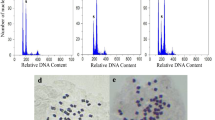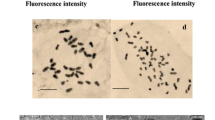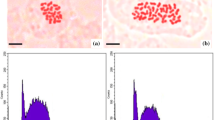Abstract
Nuruozak (Salvia leriifolia Benth), is a perennial herbaceous plant that is endemic to Iran and has recently been introduced as a medicinal plant. Artificial polyploidy is an efficient method to increase the production of secondary metabolites and can result in a whole spectrum of genetic, molecular and physiological modifications. In order to produce an autotetraploid population of nuruozak, various concentrations of colchicine (0.00, 0.05, 0.10, 0.20 or 0.50% w/v) were applied to the seeds and shoot apical meristems of young seedlings at the fourth leaf-stage. Microscopic studies, flow cytometry analysis and chromosome counting were conducted to select tetraploid nuruozak plants. Furthermore, the effects of ploidy level on the essential oil content and composition and biomass production of nuruozak plants, as well as selected structural and physiological characteristics were studied. Based on the number of the obtained tetraploids, treatment of shoot apical meristems was more efficient than seed treatment. Structural and phytochemical characteristics, chlorophyll content and photosynthetic rate were affected by the increase in ploidy level. In addition to the higher potential in biomass production, tetraploid plants produced eight new compounds which were absent in diploids.
Similar content being viewed by others
References
Hosseinzadeh, H., Sadeghnia, H.R., and Imanshahidi, M., Review of the pharmacological and toxicological effects of Salvia leriifolia, Iran. J. Basic Med. Sci., 2009, vol. 12, pp. 1–8.
Hosseinzadeh, H., Haddadkhodaparast, M.H., and Arash, A., Antiinociceptive, anti-inflammatory and acute toxicity effects of Salvia leriifolia Benth. seed extract in mice and rats, Phytother. Res., 2003, vol. 17, pp. 422–425.
Yemets, A.I. and Blume, Ya.B., Progress in plant polyploidization based on antimicrotubular drugs, Open Hortic. J., 2008, vol. 1, pp. 15–20.
Dhawan, O.P. and Lavania, U.C., Enhancing the productivity of secondary metabolites via induced polyploidy: a review, Euphytica, 1996, vol. 87, pp. 81–89.
Gao, S.L., Zhu, D.N., Cai, Z.H., and Xu, D.R., Autotetraploid plants form colchicine-treated bud culture of Salvia miltiorrhiza Bge, Plant Cell Tiss. Organ Cult., 1996, vol. 47, pp. 73–77.
Estaji, A., Hosseini, B., Dehghan, E., and Pirzad, A., Seed treatments to overcome dormancy of Nuruozak (Salvia leriifolia Bent.), IRJABS, 2012, vol. 3, pp. 2003–2008.
Dehghan, E., Hakkinen, S.T., Oksman-Caldentey, K.M., and Shahriari, Ahmadi F., Production of tropane alkaloids in diploid and tetraploid plants and in vitro hairy root cultures of Egyptian henbane (Hyoscyamus muticus L.), Plant Cell Tiss. Organ Cult., 2012, vol. 110, pp. 35–44.
Lichtenthaler, H.K. and Wellburn, A.R., Determination of total carotenoids and chlorophylls a and b of leaf in different solvents, Biochem. Soc., 1985, vol. 11, pp. 591–592.
Gregory, M.J., Menary, R.C., and Davies, N.W., Effect of drying temperature and air flow on the production and retention of secondary metabolites in saffron, J. Agr. Food Chem., 2005, vol. 53, pp. 69–75.
Adams, R.P., Identification of Essential Oil Components by Gas Chromatography and Mass Spectrometry, Carol Stream, IL., USA: Allured Publishing Co., 2005.
Ghotbi Ravandi, E., Rezanejad, F., Zolala, J., and Dehghan, E., The effects of chromosome-doubling on selected morphological and phytochemical characteristics of Cichorium intybus L., J. Hortic. Sci. Biotech., 2013, vol. 88, pp. 701–709.
Omidbaigi, R., Yavari, S., and Hassani, M.E., Induction of autotetraploidy in dragonhead (Dracocephalum moldavica L.) by colchicine treatment, J. Fruit Ornament. Plant Res., 2010, vol. 18, pp. 23–35.
Rubuluza, T., Nikolova, R.V., Smith, M., and Hannweg, K., In vitro induction of tetraploid in Colophospermum mopane by colchicine, S. Afr. J. Bot., 2007, vol. 73, pp. 259–261.
Zhang, L.Y., Guo, Q.G., Li, X.L., Zeng, H., Tan, J.M., and Liang, G.L., Study on the relationship between the number of chloroplast in stomata guard cell and the ploidy of loguat cultivars, J. Fruit Sci., 2005, vol. 22, pp. 229–233.
Warner, D.A. and Edwards, G.E., Effects of polyploidy on photosynthetic rates, photosynthetic enzymes, contents of DNA, chlorophyll, and sizes and numbers of photosynthetic cells in the C4 dicot Atriplex confertifolia L., Plant Physiol., 1989, vol. 91, pp. 1143–1151.
Mathura, S., Fossey, A., and Beck, S., Comparative study of chlorophyll content in diploid and tetraploid black wattle (Acacia mearnsii), Forestry, 2006, vol. 79, pp. 381–388.
Kondorosi, E., Roudier, F., and Gendrau, E., Plant cell-size: growing by ploidy?, Curr. Opin. Plant Biol., 2000, vol. 3, pp. 488–492.
Warner, D. and Edwards, G.E., Effects of polyploidy on photosynthesis, Photosynth. Res., 1993, vol. 34, pp. 135–147.
Levin, D.A., The Role of Chromosomal Change in Plant Evolution, Oxford, UK: Oxford University Press, 2002.
Leitch, I.J. and Bennett, M.D., Polyploidy in angiosperms, Trends Plant Sci., 1997, vol. 12, pp. 470–476.
Author information
Authors and Affiliations
Corresponding author
Additional information
The article is published in the original.
About this article
Cite this article
Estaji, A., Hosseini, B., Ghotbi Ravandi, E. et al. The effects of colchicine-induced autotetraploidy on selected characteristics of nuruozak (Salvia leriifolia). Cytol. Genet. 51, 74–81 (2017). https://doi.org/10.3103/S0095452717010042
Received:
Published:
Issue Date:
DOI: https://doi.org/10.3103/S0095452717010042




